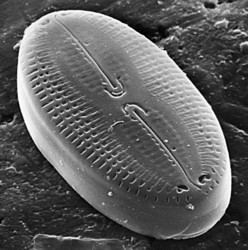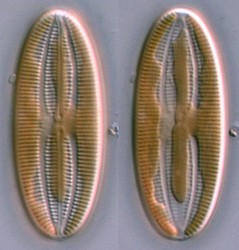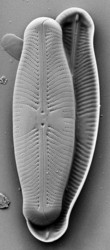Sellaphoraceae
David G. Mann


This tree diagram shows the relationships between several groups of organisms.
The root of the current tree connects the organisms featured in this tree to their containing group and the rest of the Tree of Life. The basal branching point in the tree represents the ancestor of the other groups in the tree. This ancestor diversified over time into several descendent subgroups, which are represented as internal nodes and terminal taxa to the right.

You can click on the root to travel down the Tree of Life all the way to the root of all Life, and you can click on the names of descendent subgroups to travel up the Tree of Life all the way to individual species.
For more information on ToL tree formatting, please see Interpreting the Tree or Classification. To learn more about phylogenetic trees, please visit our Phylogenetic Biology pages.
close boxIntroduction
This group of benthic raphid diatoms is found world-wide in freshwater and marine epipelon. Until the 1990s, only a few 10s of species had been described and all were classified in Navicula. It is now clear that the family contains many hundreds of species, most of which await names. The genus Sellaphora has become a model system for studying speciation and was the first to be used to explore the possibility of DNA barcoding for diatom identification.
The family Sellaphoraceae was first described in Mereschkowsky in 1902 to contain his new genus Sellaphora, which he separated from Navicula because of its saddle-like plastid. A further genus, Fallacia, was added by Mann (in Round et al. 1990), who also transferred Rossia and Caponea to the Sellaphoraceae. Microcostatus was described by Johansen & Sray (1998), but it is unclear whether this can or should be separated from Fallacia. Some species currently classified in Eolimna may belong in or near Sellaphora, but the type species of Eolimna is a fossil and it is probably impossible to assess whether it belongs to the Sellaphoraceae because of the lack of cytological or molecular data.
Most members of the family have modest dimensions (valve lengths mostly 10–60 µm) and simple shapes.
Characteristics
- small to moderate-sized raphid diatoms (mostly < 80 µm long), usually wider than deep and therefore usually lying in valve view
- usually a single H-shaped chloroplast per cell, lying with its two long lobes against the sides of the girdle and its central isthmus against the epivalve
- one or two pyrenoids per chloroplast, penetrated by finger-like invaginations of cytoplasm
- nucleus oscillatory between cell divisions (2:1 ratio of trans: cis frustules)
- valve outline elliptical, linear or lanceolate, sometimes with rostrate or capitate poles (rarely with a slight central constriction)
- striae usually uniseriate (rarely biseriate), containing simple round poroids
- valve face planar or depressed parallel to the raphe to form simple or curved grooves externally
- a conopeum sometimes present externally, extending out from the raphe-sternum over part or all of the valve face; conopeum plain (e.g. some Sellaphora) or perforated by tiny pores (Fallacia, Rossia)
- internal central raphe endings turned towards the primary side of the valve
- external central raphe endings usually deflected slightly towards the primary side of the valve
- helictoglossa narrow, elongate
- external polar raphe endings curved or hooked towards the secondary side of the valve
Discussion of Phylogenetic Relationships
Relationships between Sellaphora, Fallacia and Rossia are not yet clear. Sellaphora species have been studied extensively (using SSU rDNA, ITS rDNA, rbcL and cox1) but there are few sequences from the larger genus Fallacia and only one species of Rossia is commonly encountered.
The genera Caponea, described by Podzorski, and Microcostatus, described by Johansen & Sray (1998), both need further study.
References
Johansen, J.R. & Sray, J.C. (1998). Microcostatus gen. nov., a new aerophilic diatom genus based on Navicula krasskei Hustedt. Diatom Research 13: 93-101.
Title Illustrations

| Scientific Name | Fallacia |
|---|---|
| Specimen Condition | Dead Specimen |
| Identified By | David G. Mann |
| Life Cycle Stage | Vegetative phase |
| Body Part | frustule |
| View | exterior, SEM |
| Image Use |
 This media file is licensed under the Creative Commons Attribution-NonCommercial License - Version 3.0. This media file is licensed under the Creative Commons Attribution-NonCommercial License - Version 3.0.
|
| Copyright |
© 2008 David G. Mann

|
| Scientific Name | Fallacia |
|---|---|
| Specimen Condition | Live Specimen |
| Identified By | David G. Mann |
| Life Cycle Stage | Vegetative phase |
| View | valve focus and plastid focus |
| Image Use |
 This media file is licensed under the Creative Commons Attribution-NonCommercial License - Version 3.0. This media file is licensed under the Creative Commons Attribution-NonCommercial License - Version 3.0.
|
| Copyright |
© 2008 David G. Mann

|
| Scientific Name | Sellaphora |
|---|---|
| Creator | Frieda Christie |
| Acknowledgements | This micrograph was taken by Frieda Christie, Royal Botanic Garden Edinburgh |
| Specimen Condition | Dead Specimen |
| Identified By | David G. Mann |
| Life Cycle Stage | Vegetative phase |
| Body Part | valves |
| View | exterior and interior of two different species, SEM |
| Image Use |
 This media file is licensed under the Creative Commons Attribution-NonCommercial License - Version 3.0. This media file is licensed under the Creative Commons Attribution-NonCommercial License - Version 3.0.
|
| Copyright |
© 2008 David G. Mann

|
About This Page
This page is being developed as part of the Tree of Life Web Project Protist Diversity Workshop, co-sponsored by the Canadian Institute for Advanced Research (CIFAR) program in Integrated Microbial Biodiversity and the Tula Foundation.
David G. Mann

Royal Botanic Garden Edinburgh, United Kingdom
Correspondence regarding this page should be directed to David G. Mann at
Page copyright © 2008 David G. Mann
 Page: Tree of Life
Sellaphoraceae.
Authored by
David G. Mann.
The TEXT of this page is licensed under the
Creative Commons Attribution-NonCommercial License - Version 3.0. Note that images and other media
featured on this page are each governed by their own license, and they may or may not be available
for reuse. Click on an image or a media link to access the media data window, which provides the
relevant licensing information. For the general terms and conditions of ToL material reuse and
redistribution, please see the Tree of Life Copyright
Policies.
Page: Tree of Life
Sellaphoraceae.
Authored by
David G. Mann.
The TEXT of this page is licensed under the
Creative Commons Attribution-NonCommercial License - Version 3.0. Note that images and other media
featured on this page are each governed by their own license, and they may or may not be available
for reuse. Click on an image or a media link to access the media data window, which provides the
relevant licensing information. For the general terms and conditions of ToL material reuse and
redistribution, please see the Tree of Life Copyright
Policies.
- First online 07 February 2010
Citing this page:
Mann, David G. 2010. Sellaphoraceae. Version 07 February 2010 (under construction). http://tolweb.org/Sellaphoraceae/125705/2010.02.07 in The Tree of Life Web Project, http://tolweb.org/











 Go to quick links
Go to quick search
Go to navigation for this section of the ToL site
Go to detailed links for the ToL site
Go to quick links
Go to quick search
Go to navigation for this section of the ToL site
Go to detailed links for the ToL site